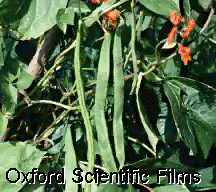
| |
 |
![]()
 Mother Earth News, Sep/Oct 1987
Mother Earth News, Sep/Oct 1987
The Easiest Seed-Saving Crops
By Nancy Bubel
Beans. Snap bean blossoms self-pollinate before they open, so there's very little chance they'll cross-pollinate. (If you have a rare old heirloom strain that you want to be sure of keeping pure, plant it 100 feet away from any other blossoming beans.) Bean seed matures about six weeks after the pods are good for eating - when it's ripe, you can scarcely dent it with your teeth. Leave the pods alone until the plants are dry, often leafless, stalks rattling in the wind. Then pull the stalks and stack them in a protected, airy place to dry for another week or two. You can shell small amounts of beans by hand. Thresh larger collections by spreading the pods on a clean sheet and whacking them with a rubber hose, broom or flail. By the way, if your seeds ripen slowly and unevenly, your soil may be short on zinc. Lima beans, dry beans and soybeans should be treated like snaps. Bumblebees like lima flowers, so the plants are likely to cross-pollinate with other limas. But they won't cross with snaps, peas, soybeans or other related legumes.
The Arc Institute
Plant in the spring after frosts are over and the soil is warm. Plant 1” deep and a few inch apart, in rows 2-3’ apart. Pole beans require poles or something to climb on. Rhizobia bacteria on the bean roots put nitrogen back into the soil. When harvesting for seed, let the pods dry on the plant, and leave the pods until they are dry and leathery unless there is a long web spell at harvest time when the pods should be picked and laid out to dry. Shell the pods when they are brittle dry. Put in airtight containers and freeze overnight to kill bugs, then store in a cool dry location.